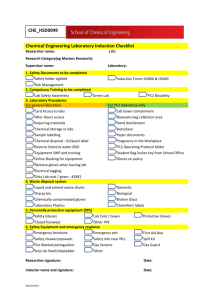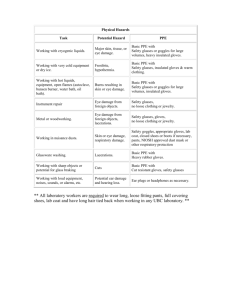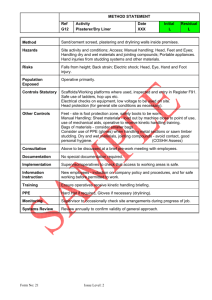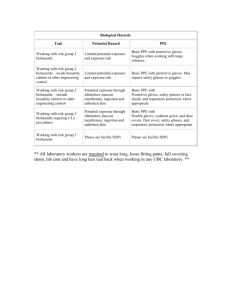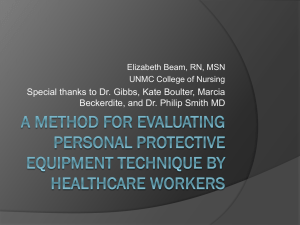PPE_Donning__Doffing__Nov25_2014
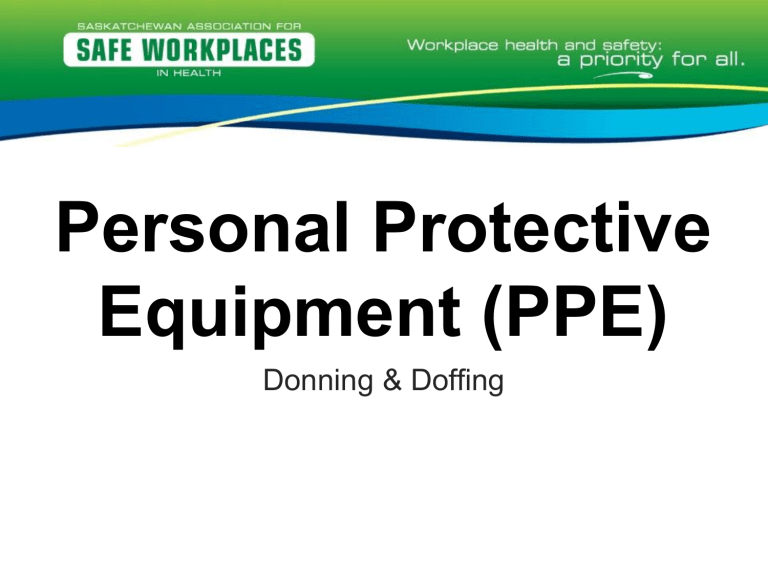
Personal Protective
Equipment (PPE)
Donning & Doffing
Housekeeping Details
Welcome & Introduction
Welcome to PPE Donning & Doffing
• Your name
• Your title
What You Will Learn
• The employer legislated responsibilities for personal protective equipment and education/training
• Your legislated responsibilities and rights as a worker
• The appropriate donning (putting on) and doffing (removing) of PPE
Legislation
Saskatchewan’s Occupational Health and Safety
Regulations, 1996, 2(1)eee states:
• “Train” means to give information and explanation to a worker with respect to a particular subject-matter and require a practical demonstration that the worker has acquired knowledge or skill related to the subject matter;
Legislation
Regulation 12(c) states:
General duties of employers
• (12) The duties of an employer at a place of employment include:
(c) the provision of any information, instruction, training and supervision that is necessary to protect the health and safety of workers at work;
Legislation
Regulation 13 states:
A worker shall:
• (a) use the safeguards, safety appliances and personal protective equipment provided in accordance with these regulations and any other regulations made pursuant to the Act; and
• (b) follow the safe work practices and procedures required by or developed pursuant to these regulations and any other regulations made pursuant to the Act.
Legislation
1. Right to Know the hazards at their workplace, to be trained to recognize them, and to be trained to protect themselves.
2. Right to Participate in their own safety as well as the safety program in their workplace.
3. Right to Refuse an act or series of acts where the worker has reasonable grounds to believe that it is unusually dangerous. This is a refusal of an individual worker, not a group of workers.
Accountability
What does accountability mean to you?
The general definition of “accountability” includes:
• being bound to give an explanation of your conduct
• being responsible; answerable.
How should we be held accountable?
Personal Protective Equipment
The purpose of PPE is to provide protection – not only to the worker, but also with eliminating or managing the risk of transferring a virus to a client or another individual.
Personal Protective Equipment
The purpose of PPE is to provide protection – for the worker, client or another individual.
• N95 Respirator
• Gown
• Gloves
• Boot/shoe covers
• Goggles/safety glasses
• Face shield
• Surgical hood
Training, Practice, Competence,
Observation
Training: this is considered your training session for donning and doffing PPE.
Ask questions if you’re not sure about something.
Practice: we will practice donning and doffing each piece of equipment.
Perfect practice makes perfect. This will take time, we’ll practice very slow
and deliberate - this is a task that we will not rush through. After you leave this session, keep practicing and use another trained person to observe you.
Competence: this is your “know how”, your ability to use what you will be taught today. So “know how” to don and doff properly before you leave this session.
Observation: this is where I am going to watch and coach each of you don and doff every piece of PPE .
Principles of PPE
Donning
• PPE must be donned correctly in proper order before entry into patient care area.
During Patient Care
• PPE must remain in place and be worn correctly for the duration of exposure to potentially contaminated areas. PPE should not be adjusted during patient care. Don’t adjust your eyeglasses, hair, etc. Don’t touch any part of your face.
• Having a “buddy” with you during patient care will help to check for a partial or total breach in PPE
Doffing
• The removal of used PPE is a high-risk process that requires a structured procedure, a trained observer when using High Risk Ebola procedures, and a designated area for removal to ensure protection.
• PPE must be removed slowly and deliberately in the correct sequence to reduce the possibility of self-contamination or other exposure viruses, such as Ebola
.
Remember!
• Always move slowly – it is a step by step task
• Do not rush when donning PPE
• Avoid touching PPE once donned
• Avoid touching face, exposed skin
• Do not rush when doffing PPE
• Use appropriate waste receptacle (preferably hands-free) and discard carefully
Donning & Doffing – Basic PPE
Use the following safe work practices to protect yourself and limit the spread of contamination:
• Keep your hands away from your face and limit the surfaces you touch.
• Change gloves when torn or heavily contaminated.
• Regularly perform hand hygiene. An alcohol based hand rub (ABHR) is the preferred method to clean hands. If hands look or feel soiled, use soap and water to clean hands.
Donning Sequence – Basic PPE
Proper hand hygiene is first, then followed by:
1. Shoe covers or booties
2. Gown
3. Mask/respirator
4. Goggles/Face Shield
5. Gloves
Doffing Sequence – Basic PPE
1. Shoe covers or booties
2. Gloves
3. Gown
4. Goggles/face shield
5. Mask/respirator
Proper Hand Hygiene
Low Risk Ebola Virus Disease (EVD)
• Encounter with patient suspected to have EVD who is mildly symptomatic: mild fever, fatigue, headache, sore throat, muscle pain.
• Decision to upgrade to higher level of protection is based on your assessment of risk in each patient care situation. If risk is high, use the high risk protocol.
• Trained observer and checklist is not required for a low risk encounter; however, HCWs are encouraged to request assistance, if needed.
• Ensure you are signed into the log book prior to entering patient room.
• Move slowly; do not rush when putting on PPE before entering the patient room.
Donning Sequence - Low Risk EVD
1
.
Hand hygiene
2. Surgical gown
3. Mask
4. Full face shield
5. Nitrile gloves
Doffing Sequence - Low Risk EVD
1
.
Disinfect gloves
2. Inspect PPE
3. Remove gloves
4. Remove gown
5. Hand hygiene
6. Remove face shield
7. Remove mask
8. Hand hygiene
Trained Observer - High Risk EVD
• Dedicated; sole responsibility ensuring adherence to the entire process
• knowledgeable in the facility’s protocol; correct donning and doffing procedures, including disposal of used PPE
• reads aloud each step; visually confirm and document that step has been completed correctly
• ensures the worker avoids touching their face/exposed skin during the donning and doffing procedure
• provide guidance/technique recommendations
• monitors and documents successful donning and doffing procedures, providing immediate corrective instruction steps not followed
• inspects PPE for gaps and adjusts if necessary
• range of motion activities - PPE stays intact and worker comfort
• know exposure management plan - unintentional break in procedure
Trained Observer PPE- High Risk EVD
• Single-use (disposable) fluid-resistant or impermeable gown that extends to at least mid-calf
• Single-use (disposable) full face shield
• Single-use (disposable) nitrile gloves with extended cuffs. Two pairs of gloves should be worn. At a minimum, outer gloves should have extended cuffs.
• Single-use (disposable) fluid-resistant or impermeable shoe covers. Shoe covers should allow for ease of movement and not present a slip hazard to the worker.
Trained Observer PPE- High Risk EVD
Donning Sequence:
1. Hand hygiene
2. Shoe/boot covers
3. Hand hygiene
4. Nitrile gloves
5. Surgical gown
6. Full face shield
7. Extended cuff nitrile gloves
8. Inspection
Trained Observer PPE- High Risk EVD
Doffing Sequence:
1. Remove outer gloves
2. Disinfect inner gloves
3. Remove surgical gown
4. Remove shoe/boot covers
5. Remove inner gloves
6. Hand hygiene
7. Don new gloves
8. Remove full face shield
9. Remove gloves
10. Hand hygiene
Trained Observer - High Risk EVD
Checklist for donning
•
Check off as completed
•
Date/time and signatures
Checklist for doffing
•
Check off as completed
•
Date/time and signatures
High Risk Ebola Virus Disease (EVD)
Patient is confirmed to have Ebola Virus Disease
OR
Patient is suspected to have Ebola Virus Disease
AND
• has high risk symptoms such as bleeding or uncontrolled diarrhea or uncontrolled vomiting; or
• is unstable and requires a high risk procedure such as an aerosol generating medical procedure (includes intubation, open respiratory/airway suctioning, high-frequency oscillatory ventilation, nebulized therapy, non-invasive positive pressure ventilation), cardiopulmonary resuscitation, central line insertion, or any procedure that could potentially result in copious amounts of body fluid generation or exposure
PPE Storage and Donning Area
High Risk EVD
• An area outside of the patient room (e.g., nearby vacant patient room or a marked area in the hallway outside the patient room) where clean PPE is stored and where healthcare workers can don PPE under the guidance of a trained observer before entering the patient room
• Post appropriate signage indicating room designation and purpose
Pre-Donning Activities
High Risk EVD
• Ensure all required PPE and supplies are available
• Ensure you are signed into log book
• Remove all personal items (e.g., jewelry, cell phones, etc.)
• Ensure longer hair is tied back
• Remove personal clothing and change into scrubs and dedicated washable shoes (fluid resistant footwear-closed toe and heels, plastic or rubber soles)
• Hydrate (no drinking or eating is allowed in patient care area)
• Ensure trained observer, in appropriate PPE, is available to document the steps of the donning checklist with you
Donning Sequence - High Risk EVD
1. Hand hygiene
2. Knee high boot covers
3. Hand hygiene
4. N95 respirator
5. Nitrile gloves
6. Surgical Gown
7. Apron (if used)
8. Surgical hood
9. Full face shield
10. Extended cuff nitrile gloves
11. Inspection (including range of motion)
PPE Doffing Area - High Risk EVD
• Designate an area in close proximity to the patient room (or alternate area as per the Ministry of Health procedures)
• Provide supplies for disinfection of PPE and for hand hygiene
• Provide a space for sitting to remove boot covers
• Provide leak-proof infectious waste containers for discarding used PPE
• If a hallway is being used outside the patient room, construct physical barriers to close hallway to traffic (thereby creating an anteroom)
• Post appropriate signage indicating room designation and purpose
Pre-Doffing Activities - High Risk EVD
Worker
• Ensure trained observer is available to monitor, assist (where required), document the steps of PPE doffing checklist
Trained Observer
• Don shoe covers, gown, face shield, and gloves to assist worker with removal of PPE
• Prepare a doffing pad that is marked section 1 and section 2
• Read aloud each step of the PPE doffing procedure; provide reminders to avoid reflexive actions such as touching their face
PPE Items shall be removed slowly and carefully and discarded one piece at a time in a hands-free waste receptacle
Doffing Sequence - High Risk EVD
1. Disinfect outer gloves
2. Clean door handle
3. Inspect
4. Remove outer gloves
5. Disinfect inner gloves
6. Remove gown
7. Remove knee high boot covers
8. Remove inner gloves
9. Perform hand hygiene
10. Put on new gloves
11. Remove face shield
12. Remove gloves
13. Perform hand hygiene
14. Put on new gloves
15. Remove surgical hood
16. Remove gloves
17. Perform hand hygiene
18. Remove N95 respirator
19. Perform hand hygiene
20. Put on new gloves
21. Clean shoes
22. Remove doffing pad
23. Remove gloves
24. Perform hand hygiene
To Protect Yourself, You Can:
• Ask for training on PPE
• Use the appropriate PPE
• Keep yourself current on PPE
• Practice – perfect practice makes perfect
• Know the current policy and procedures
Bringing it All Together
• PPE will be provided by the employer
• Staff will be trained on appropriate donning and doffing techniques
• Follow guidelines in place; refer to documents available
• Ask for help if you need it
• “Buddy up”
